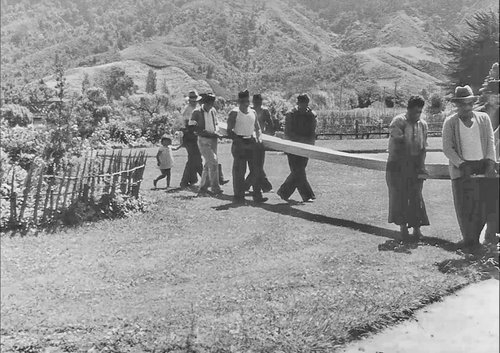
Ngā Taonga Sound & Vision joins the rest of Aotearoa in farewelling the first beauty queen of Māori descent.
Moana-Nui-a-Kiwa Manley, of Ngāti Pikiao, Ngāti Tarawahi and Tūhourangi descent, was the first Māori woman to represent Aotearoa/New Zealand in overseas beauty pagents including Miss Universe and Miss World in the early 1950s. She also carved out an accomplished sporting career, particularly as a swimmer.
Few people know of Moana’s contribution to our film heritage. Her father, Reginald George Harwood Manley (known as Jim Manley), was commissioned by Te Kirihaehae Te Puea Herangi to record the construction of three waka taua for the 1940 commemorative centennial of the signing of Te Tiriti o Waitangi. Princess Te Puea had orginally hoped to see seven waka representative of the migratory fleet from Hawaiki, however due to a shortfall in funding only three were completed.
In 1938, Jim Manley captured moving visual material, including footage of Moana as a child, of the two canoes that were built at Tūrangawaewae Marae in Ngāruawāhia; Aotea and Takitimu, now known as Tūmanako and Rangatahi respectively. The third canoe Ngātokimatawhaorua, now housed at the Waitangi Treaty Grounds, was completed at Kerikeri and launched on January 2nd, 1940 for sea trials in preparation for the February 6th 100th anniversary at Waitangi that year. All three waka are still used today in major ceremonial and iwi driven events.
The films were transferred into the care of the then New Zealand Film Archive collection during the 1980s, before being edited with full sound effects and voice over, and released as Mana Waka as part of the sesqui-centennial celebrations in 1990.
E te mareikura purotu o te ao hākinakina, ātanga anō hoki, haere.
Haere ki roto i a rātou o te wāhi ngaro.
Haere whakahokia ki te kāinga tūturu ma tāua te tangata, ki Hawaikinui, Hawaikiroa, ki Hawaikipāmamao.
E moe, e moe, e moe...
Hero image: Framegrab from Mana Waka showing Moana as a child at Ngāruawāhia during the construction of Aotea and Takitimu canoes now known as Tūmanako and Rangatahi respectively. Ngā Taonga Sound & Vision reference: F4973